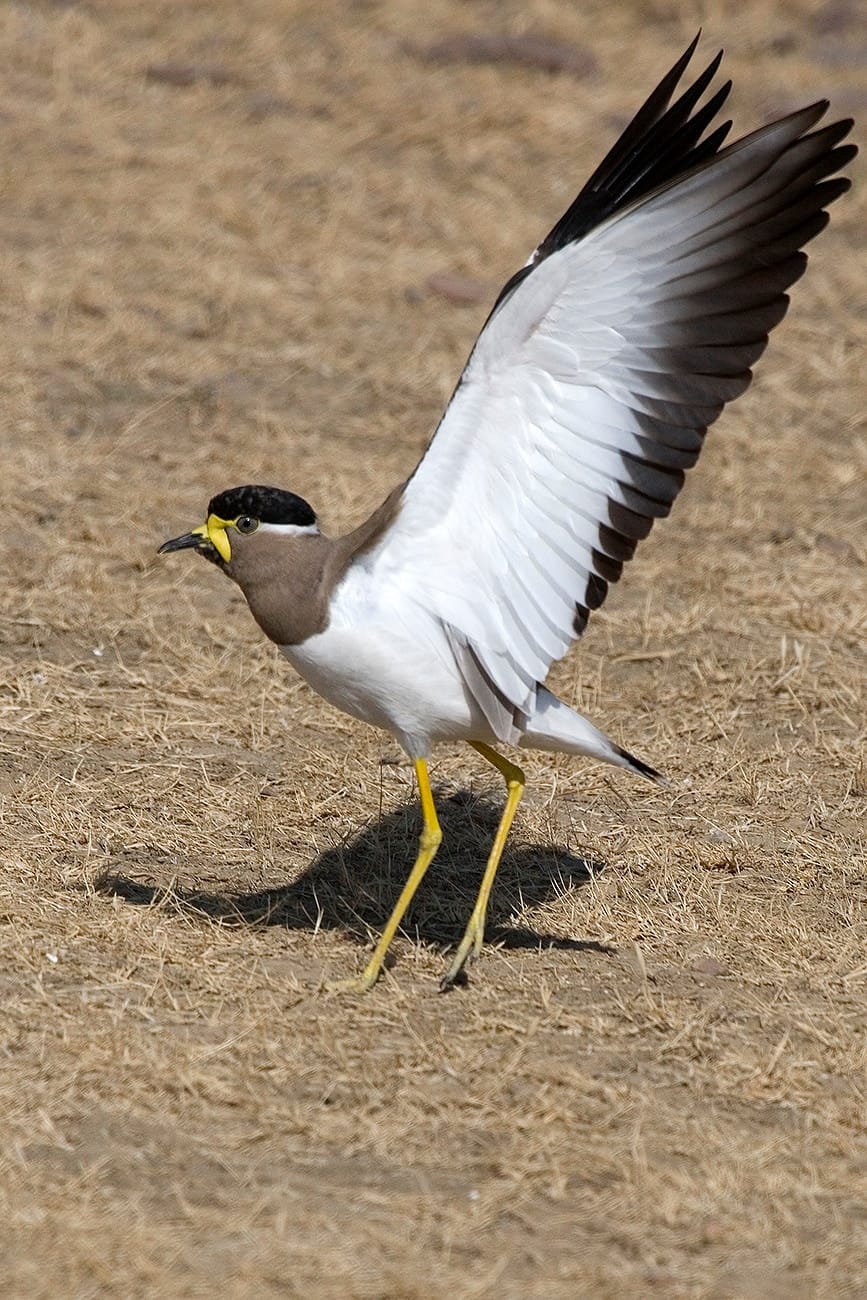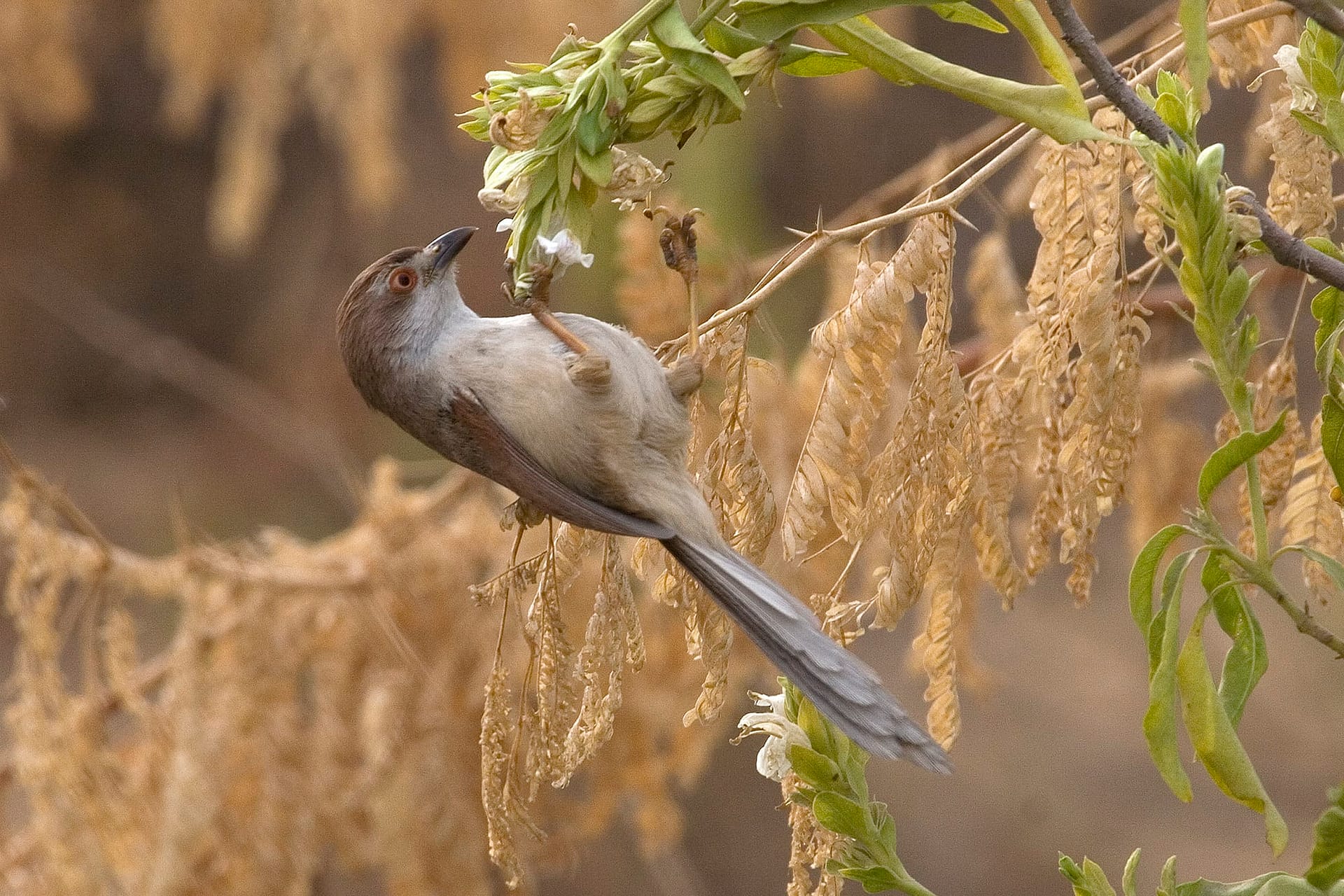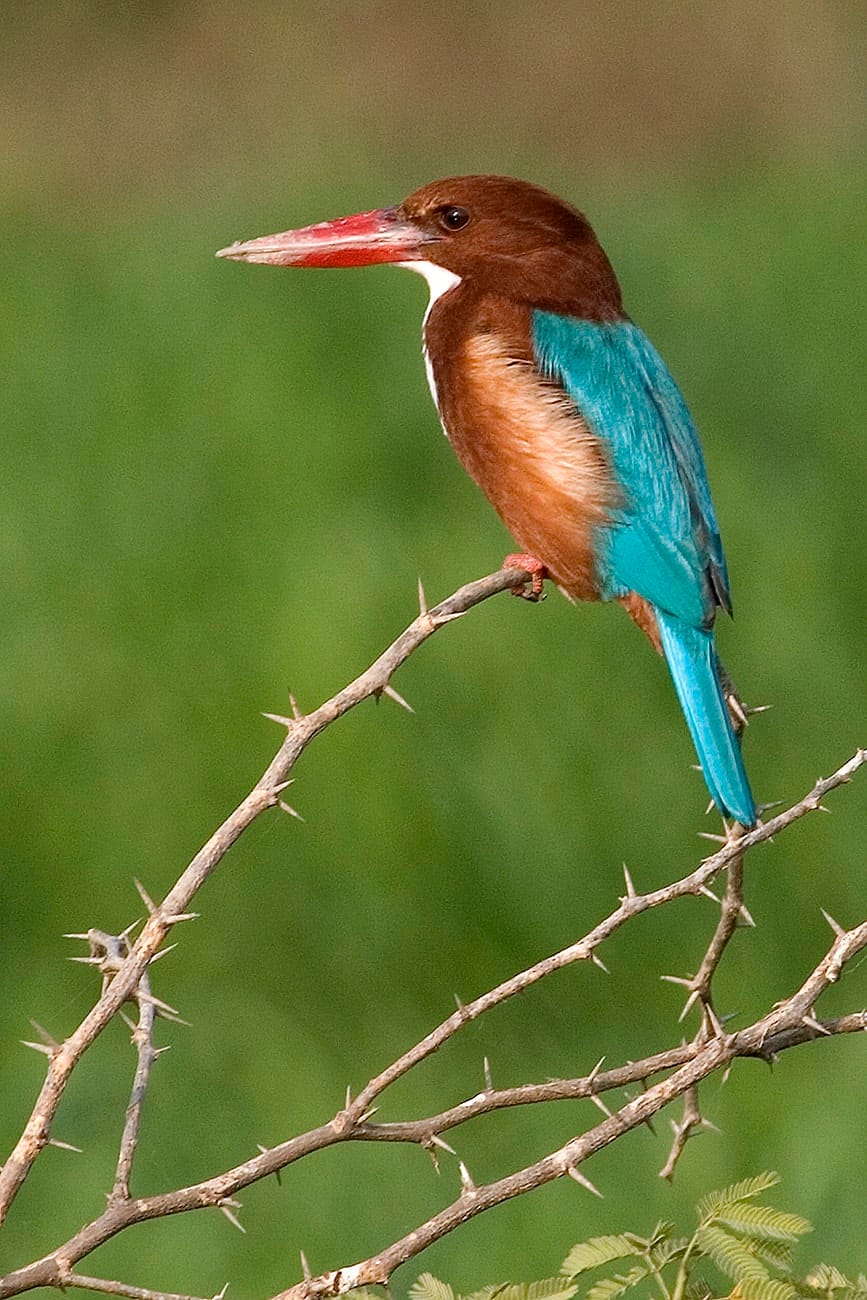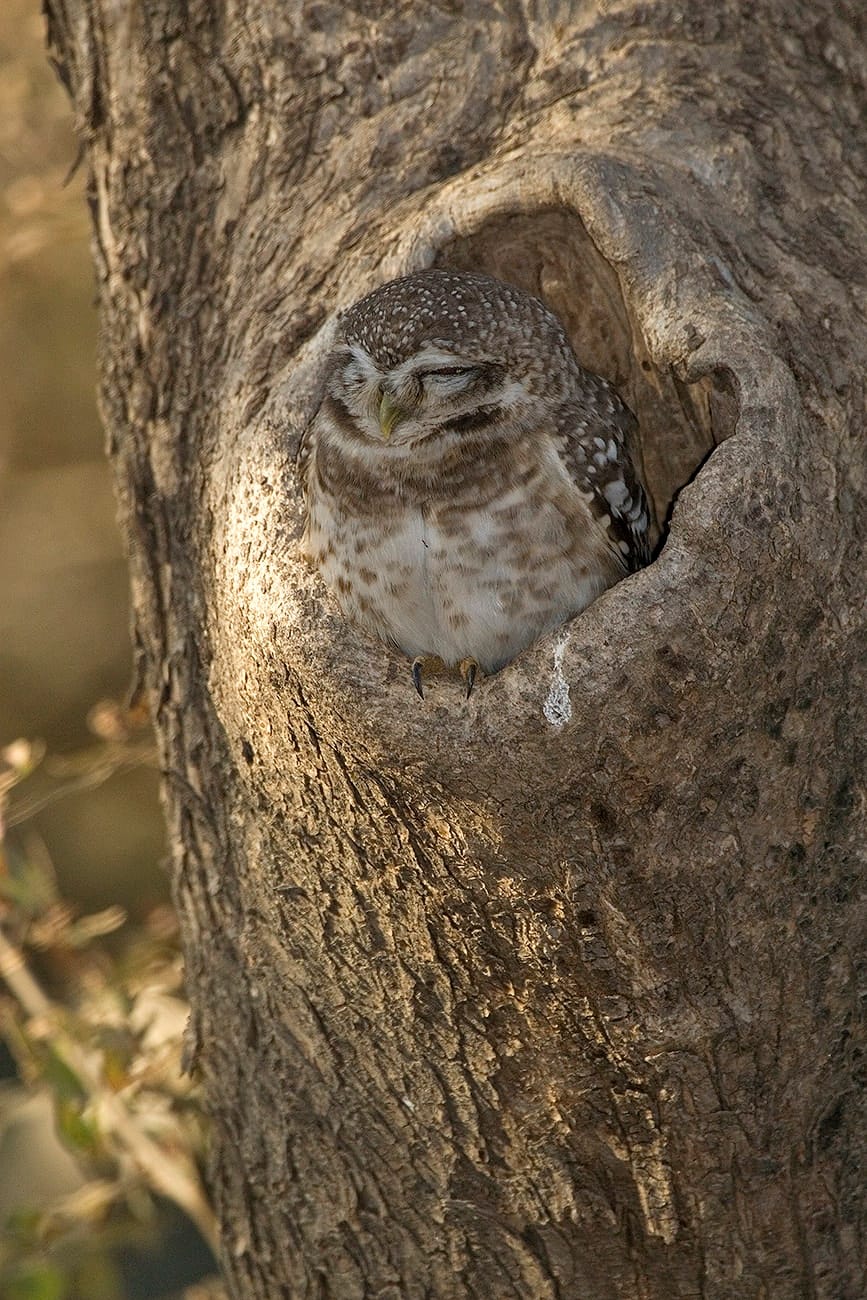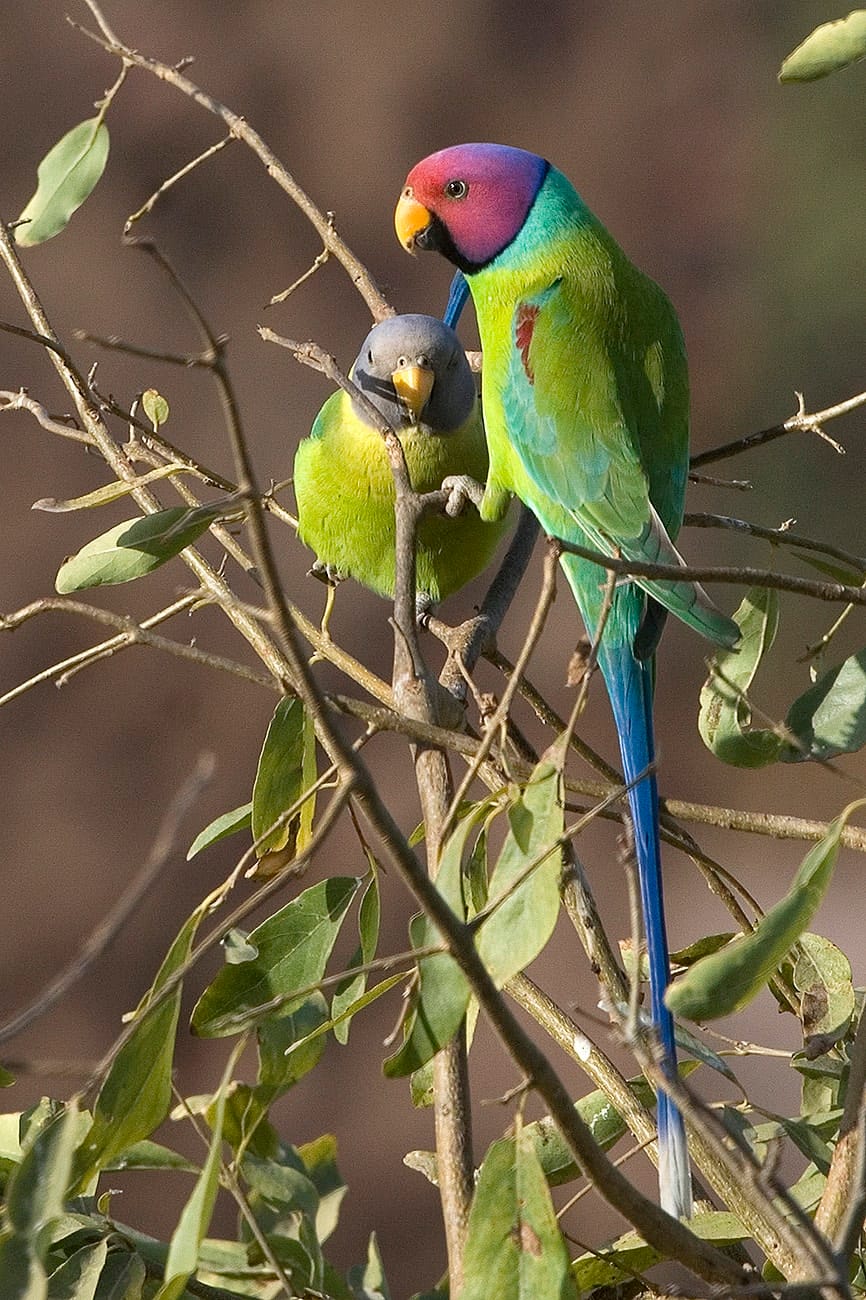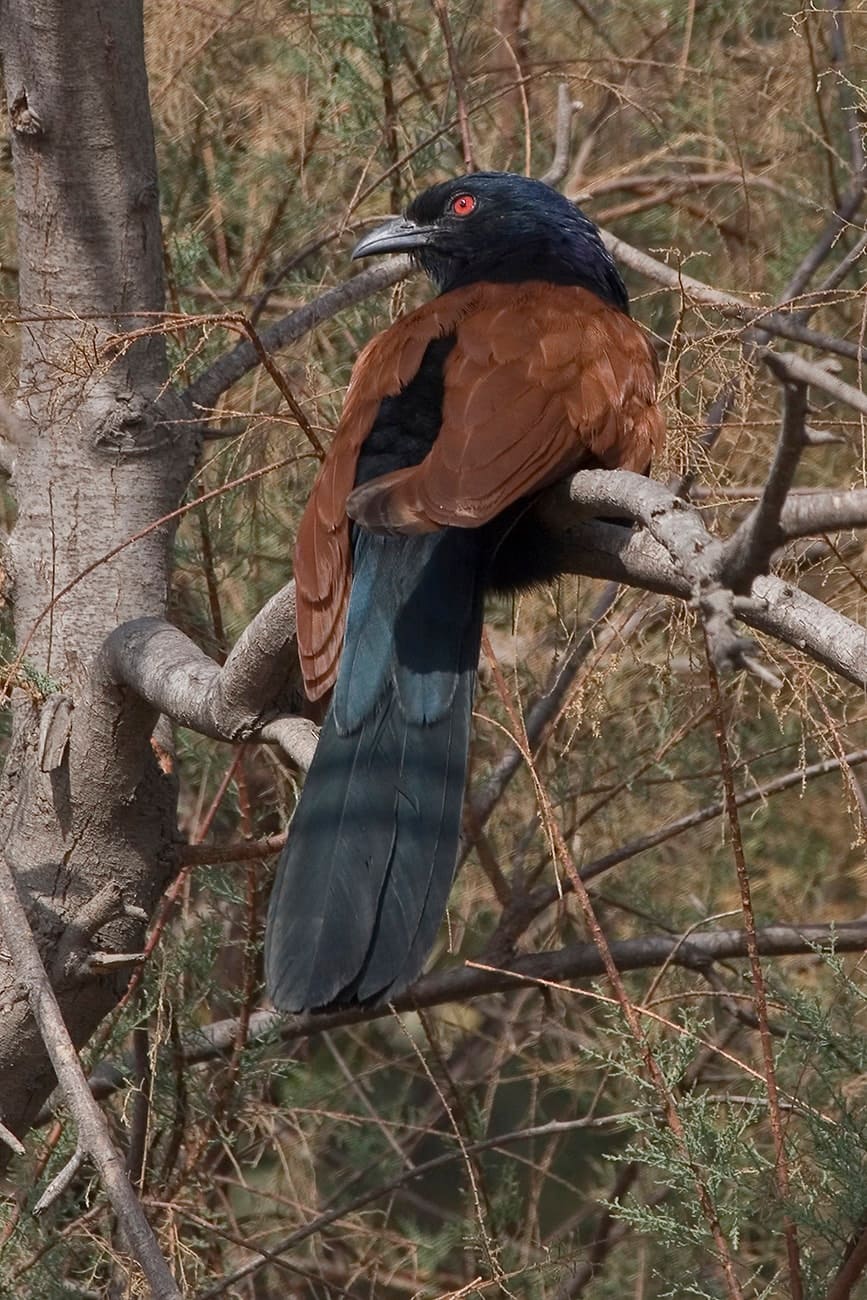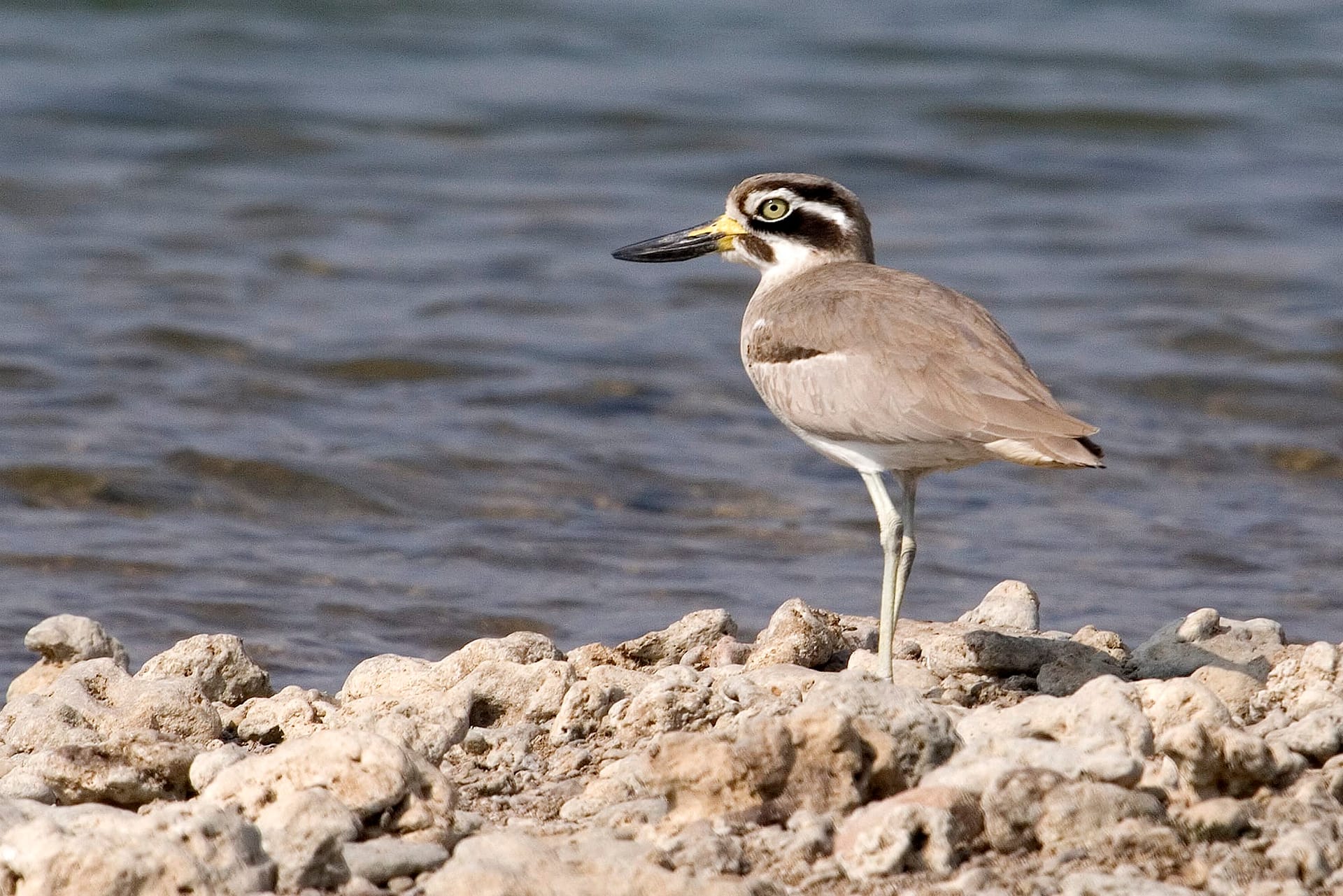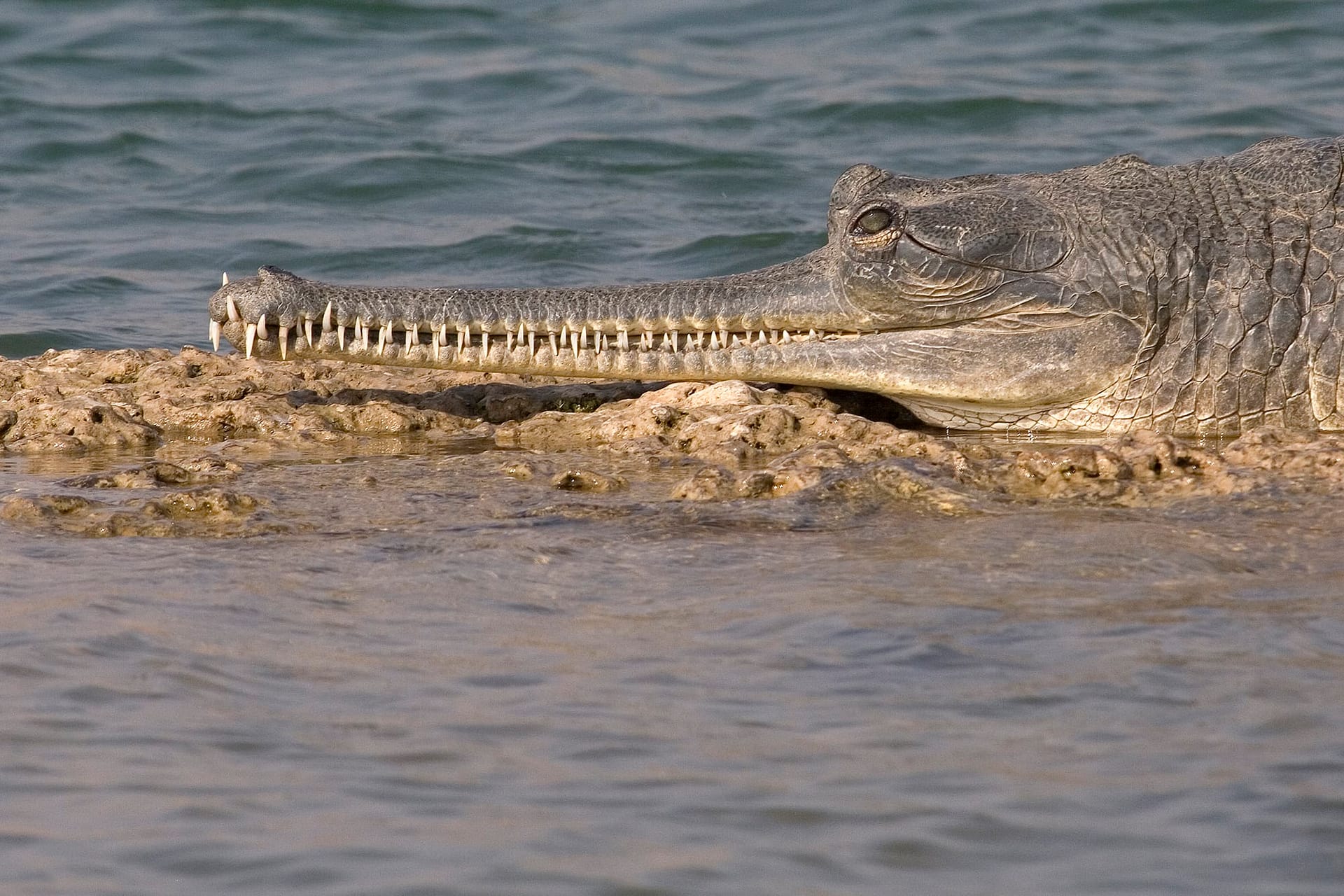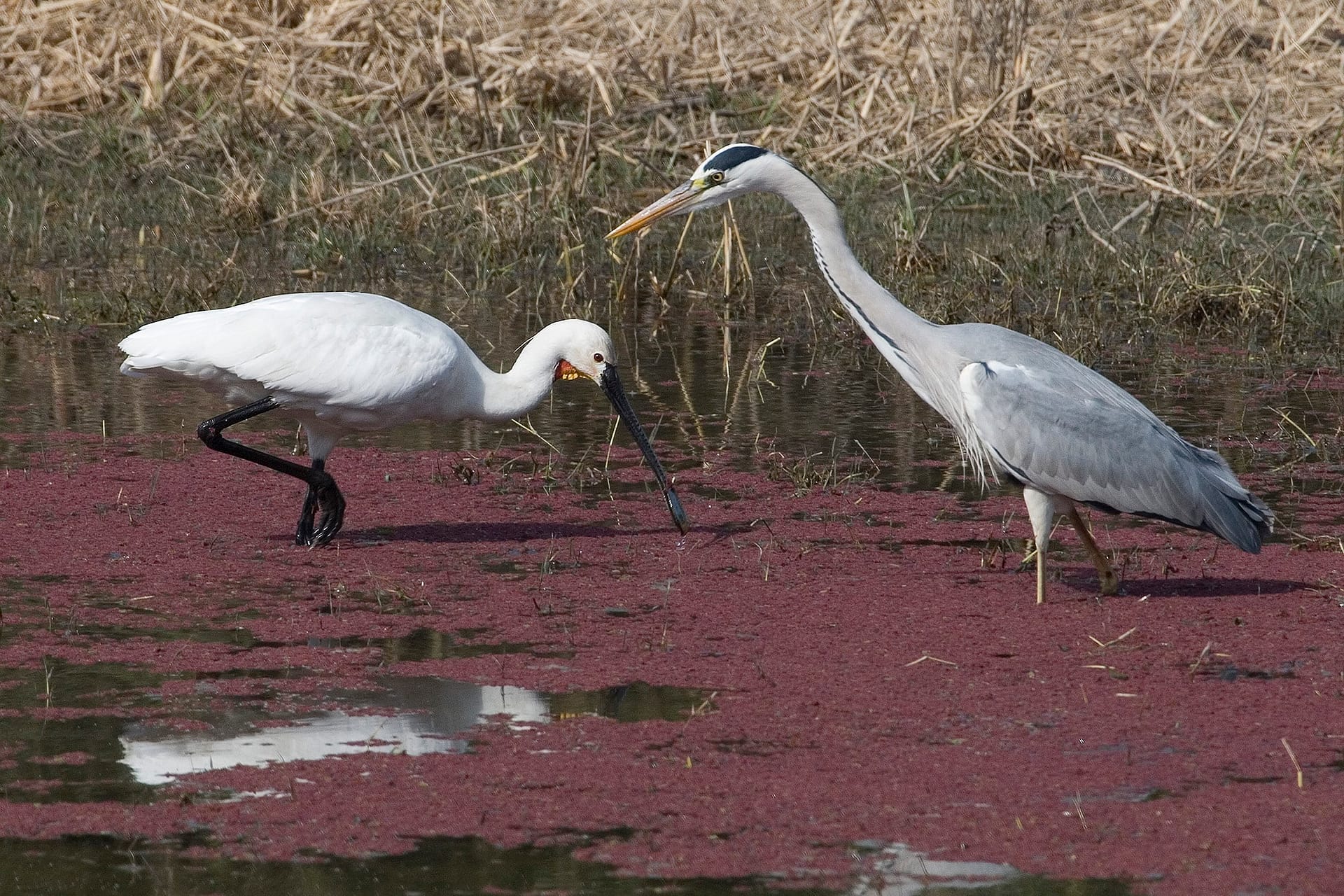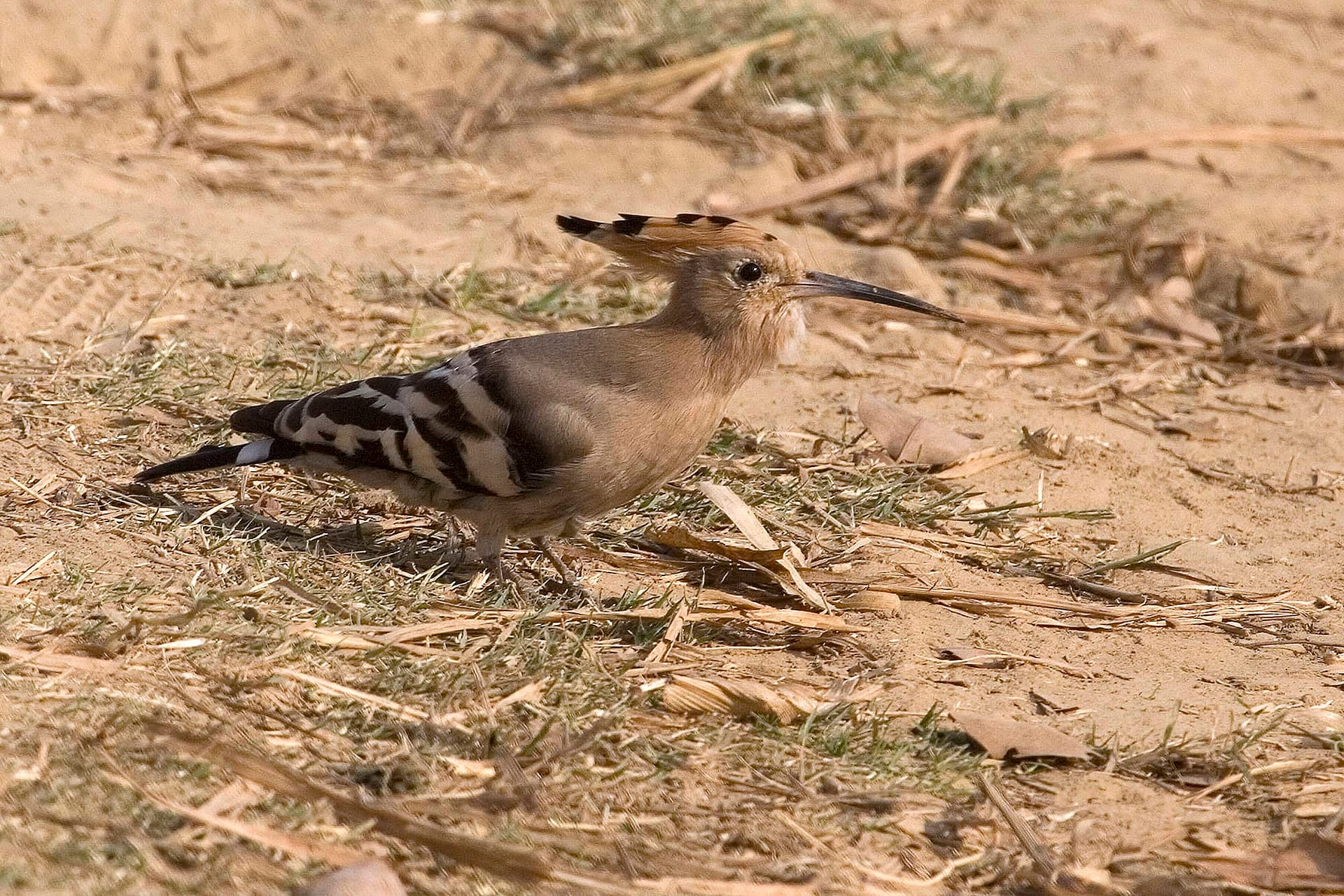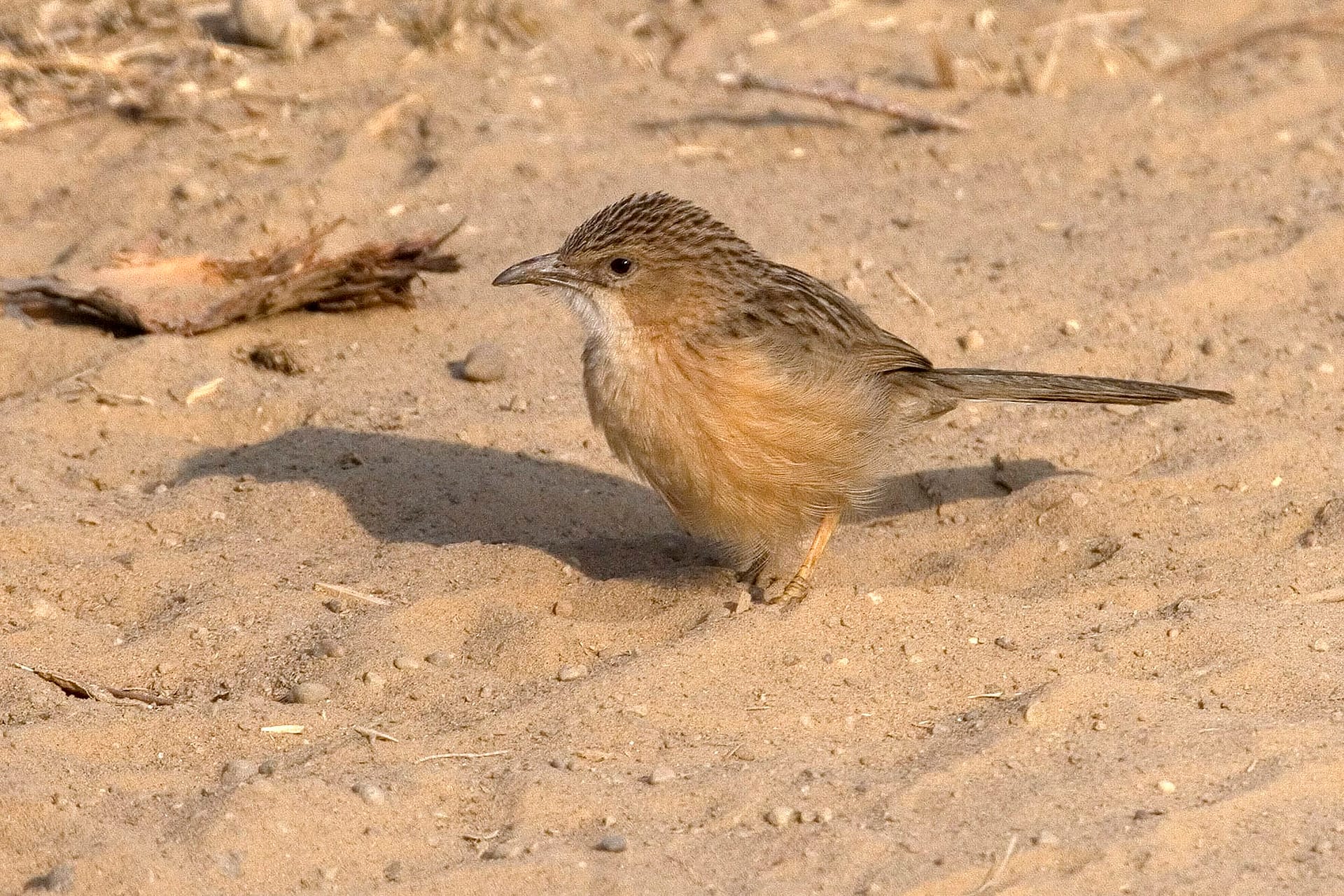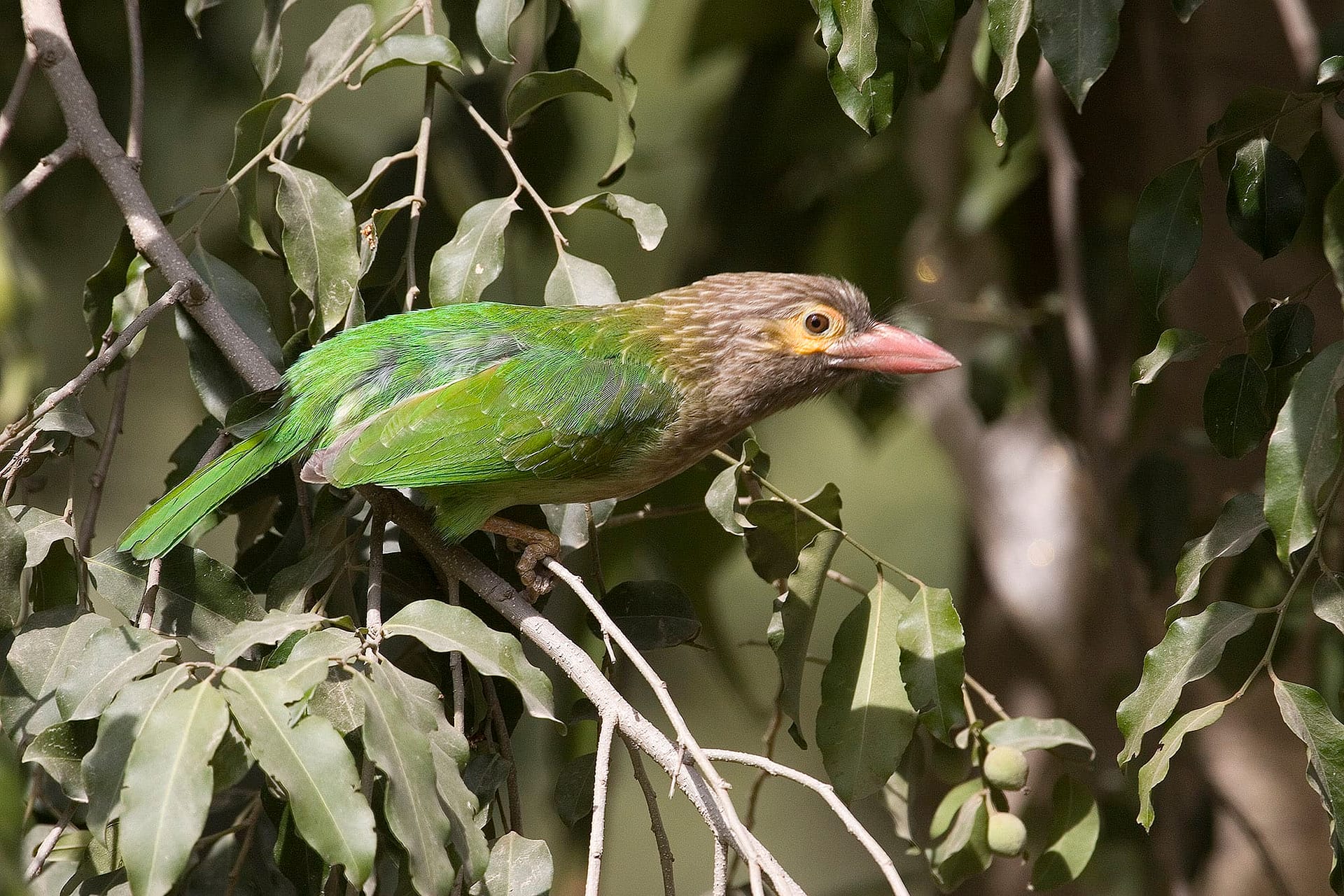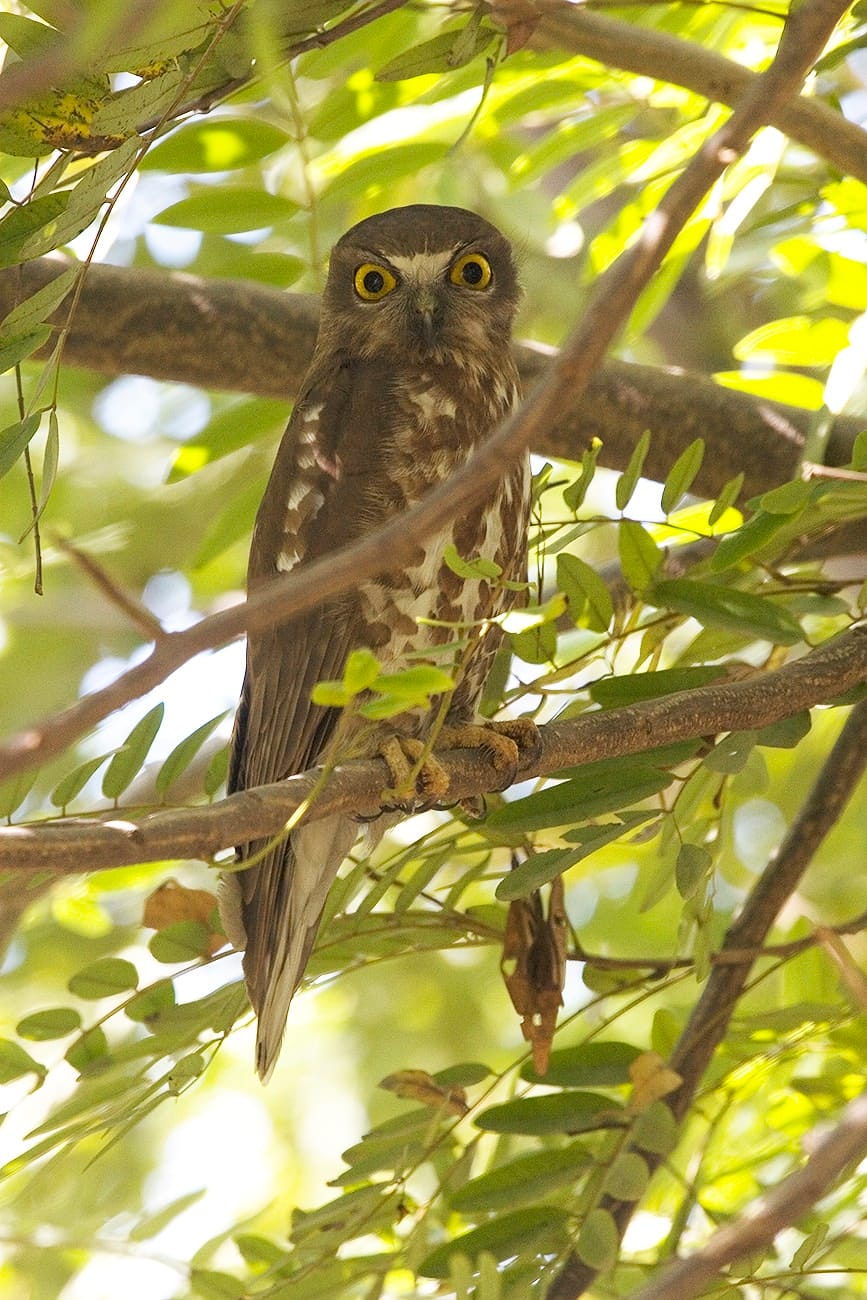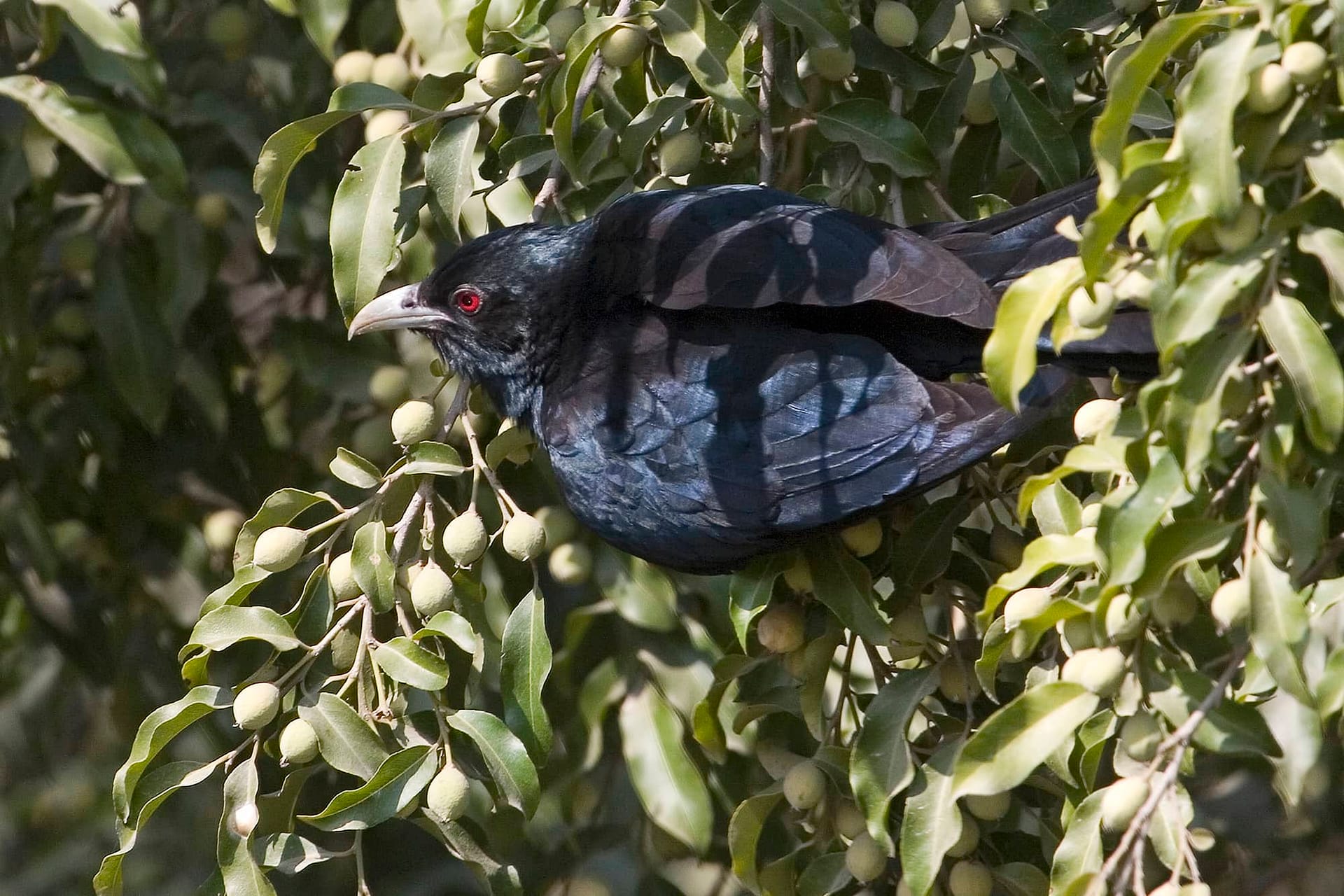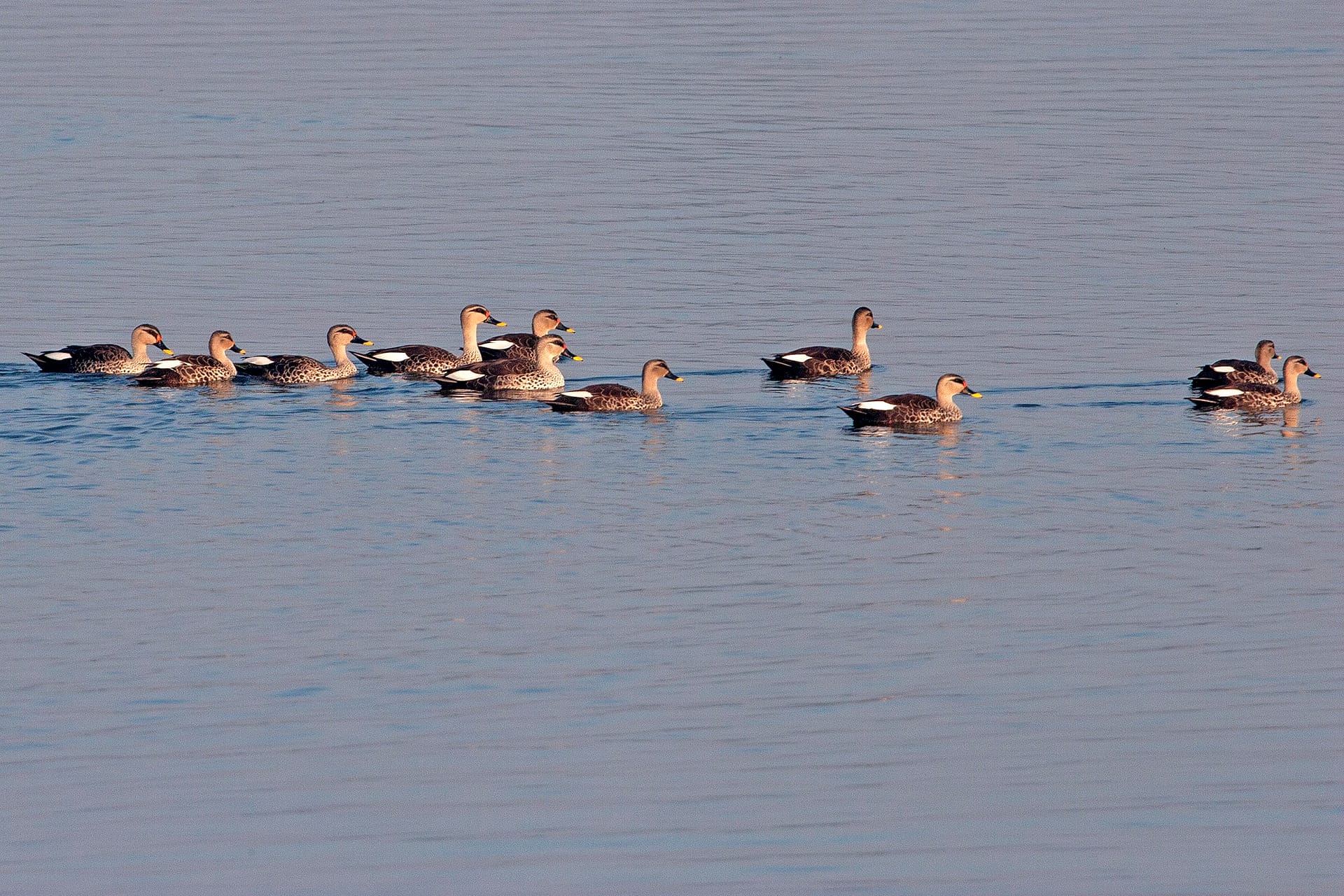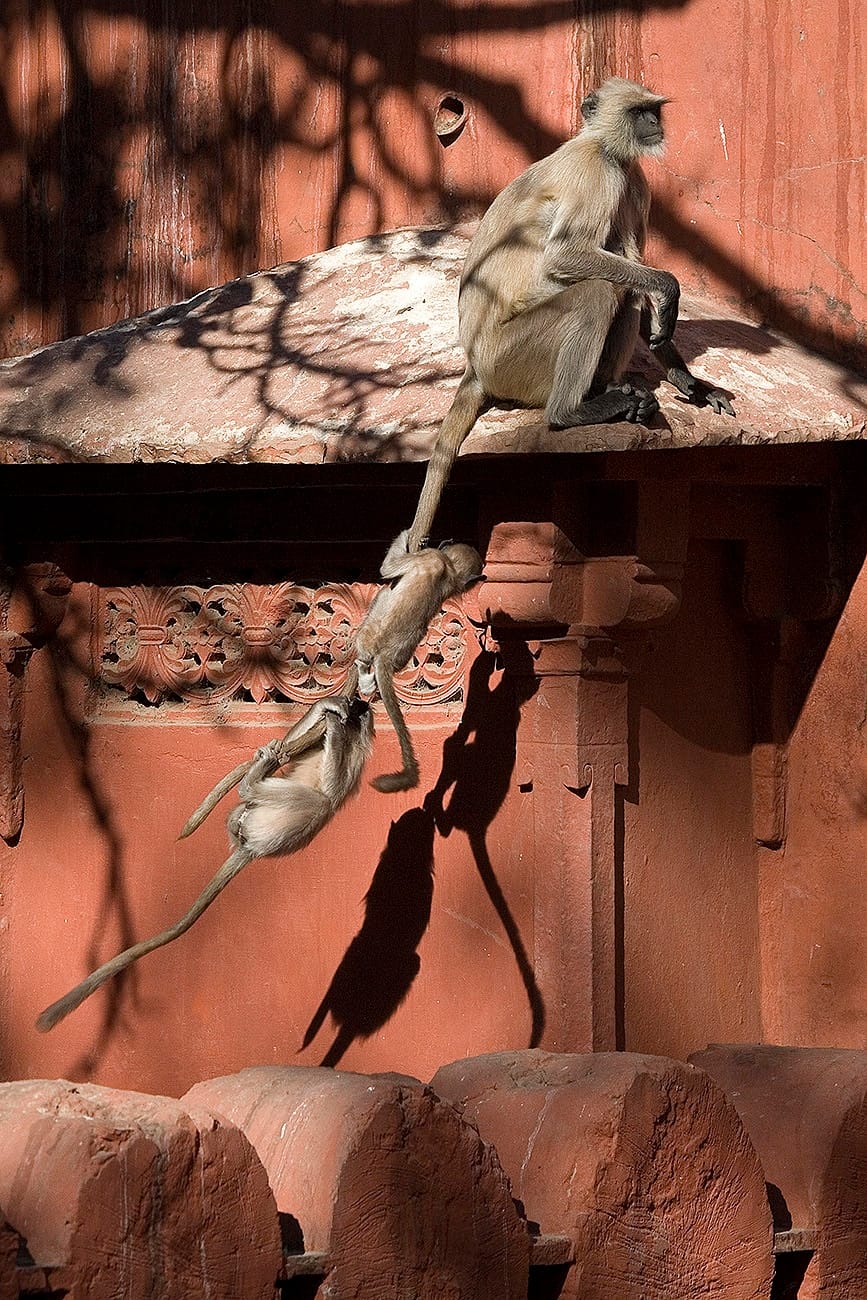TRIP REPORT: INDIA – 2008 January – Wildlife Safari

TOUR FOCUS
TRIP LEADERS
PRIVATE TOUR OPTION
This tour is available as a private trip for any size group. The tour cost will vary with the number of people and any custom requests.
TESTIMONIALS
Rajasthan Trip Report by Adrian Binns
Day 1 / Jan 9 – Delhi to Jaipur
Following our arrival into Delhi in the late hours last night, it was a short nightʼs sleep for Jim, Barb and I. At breakfast we met Frank and Pat who had opted to fly in a day early. A quick walk around the Country Resort before we left for Jaipur gave us an opportunity to get some of the common garden birds under our belts, namely Red-vented Bulbul, House Crows, Eurasian Collared Doves, noisy Rose-ringed Parakeets and Common Mynahs, Purple Sunbird and a couple of Black Drongos.
Once on the new highway, which when completed in 2 years will have 6 lanes all the way to Jaipur (just in time for the Commonwealth Games) we passed the time being amazed at the driving skills, or lack of, of anyone behind a wheel. The various taxis overflowing with humans gave us a chuckle some with doors open as passengers hung on for dear life. Once away from the suburbs and for about half of the 265 kms we passed endless fields of tall mustard and short rice. We passed a group of eight Indian Peafowl and saw a small group of Comb Duck feeding in a roadside sewage pool. We did a u-turn and had a wonderful 20 minutes not only with great looks at these small geese, but at an assortment of close waterbirds -White-tailed and Red-wattled Lapwings, Ruff, the ubiquitous Black-winged Stilts, Spotted Redshank, Marsh, Green, Wood and Common Sandpiper and Citrine Wagtail. In the scrub in front of us Indian Robin and both Plain and Ashy Prinia; on the wires White-throated Kingfisher, Rock Pigeon, loads of Eurasian Collared Doves, a lone Red-collared Dove and the gorgeous Eurasian Hoopoe flying by us. Heading south we made a brief pit stop in ʻmidwayʼ as we still had a couple of hours to go. Frank spotted a roadside ad for wedding receptions up to 3000 people! Camels drawn carts became more numerous and we knew we were nearing Amber once we spotted mahouts on their elephants heading to lunch. We took advantage of the perfect light on the Amber Fort and briefly stopped for photos. 5 minutes later we were opposite the hunting lodge on the lake in Jaipur and at the Trident Hotel. The flowering bougainvillea hosted Purple Sunbirds and above us we could see a few Dusky Crag Martins.
Following lunch we met up with our city guide TK, love those easy names, and made our way passed colorful camels and elephants into the heart of the “Pink City”. They have made a conscientious effort to clean up the city and it shows. Though by no means spotless it has meant that we no longer had to dodge a plethora of sacred cattle. Our first stop was the outdoor Observatory built in 1728 by the 1st Maharajah. Many sundials in all sizes and geometrical shapes adorn the several acre site a stoneʼs throw from the City Palace. We picked some new birds here including brown Rock Chat and Brahminy Starling, and excellent looks at a pair of Coppersmiths and Green Bee-eaters. Once in the City Palace we had House Sparrows and Yellow-footed Green Pigeon. The tour included a visit to the humongous urns, the museum, the art gallery which included a portrait of the ʻJohn Lennonʼ Maharajah and a personalized demonstration with one of the excellent artists at the Master Artists and Craftsmen hall. On the way back to the hotel we made one stop at the Textile factory to see firsthand block printing and the ladies each got a small memento of the handwork.
Day 2 / Jan 10 – Jal Mahal Lake; Amber Fort; Jaipur to Sawai Madhopur
The day began with a beautiful orange sunrise over the old maharajas hunting lodge on Jal Mahal Lake. The narrow islands of debris close of the shoreline held an assortment of shorebirds including a white Ruff, a Reeve and several Common Snipe. Our first ducks were a pair of distant Gadwalls and Common Teal and a lone Grey Heron was on a dead snag inches above the waterline. Along the shoreline and shrubby bank we came across all three wagtails, Citrine, Yellow and Black as well as a Pied Bushchat. We would return here later in the morning and add Chiffchaff, Tawny Pipit, Common Redshank, Kentish Plover and both Little and Indian Cormorant.
At 8 oʼclock we headed into the city center to take photographs of the Palace of the Winds, a remarkably ornate facade of elaborate windows that allowed the palace women to look down upon the outside the world. Three quarters of an hour later we were waiting in a small queue for our elephant ride up to the Amber Palace. What did not sit too well with us was the fact that they allowed 2 busloads of tourists to jump the queue which meant our 10 minute wait turned out to nearer half an hour. We all boarded our decorated elephants in twos except for me who got one all to myself for the 15 minute ride to the top. The palace was built of marble and red sandstone between 1590 and 1640 and it is currently undergoing a restoration though the vast majority of it is in pretty good shape for being that age. During the height of its era it held 700 people 500 of whom were workers of various degrees including many food tasters. Always keeping an eye to the sky as TK guided us through a maze of rooms we managed to see a Shikra glide past us and scored with good views of a Red-headed Vulture and 3 silhouetted Bonelliʼs Eagles.
After a slight confusion over whether we would get an a la carte or a buffet lunch, in the end in was the later, we were on the road to Sawai Madhopur by 1 oʼclock, though it took us all of three quarters of an hour to get through the three million people that make up Jaipur. We stopped at a lake just north of Chaksu which was teeming with waterfowl most of which were Shovelors, Pintails and Common Teal. Also there were Eurasian Coot, Pochard, Little Grebe, River Tern and Pied Avocet while the adjacent woods had Black Redstart, Chiffchaff, Lesser Whitethroat and Red-throated Flycatcher. Following the 20 minute break it was not until we neared Tonk that we began to pick up our first Southern Grey Shrikes. Once we made the turn at Tonk the road which had been very good (itʼs all relative) to that point, though slow, got worse with road works and uneven surfaces making it brutally slow, but the birding did pick up. Black-shouldered Kites, Black Drongoʼs and a scattering of Green Bee-eaters was nice to see as were square plots of red Rajasthan chiliʼs laid out to dry. We made various stops to look at birds that were very close to us. These included Common Babbler, White-breasted Waterhen, Grey Francolin, Long-tailed Shrike, Spotted Owlet and one that was for a White-throated Kingfisher but produced an even closer male Greater Painted-Snipe that even showed its threatening display. Just after 6:30 we made the steady climb up the final section of road to the Castle Jhoomer Boari having had a long by fruitful journey.
Day 3 / Jan 11 – Ranthambhore NP: AM Track 2 ; PM Track 1
The big day had arrived and this was our first crack at the most majestic of beasts, the Tiger. Breakfast was at 6am and not long afterwards we were loading up our canter and along with our guide Pankaj we were on our way into the park. First the formalities of checking in, getting the paperwork sorted out and drawing a number out of a bag that would be our assigned track for the morning. By 6:50 and still well before sunrise we were through the main gate and made our first stop for a pair of roosting Indian Scops Owls. Indian Peafowl were plentiful including a tree with at least two dozen and at the fort gate Jungle Babblers and Rose-ringed Parakeets were feeding on the seed that had been laid out for them. We soon came across new species such as Plum-headed Parakeets, White-bellied Drongo, Large- billed Crow, Grey Wagtail, many Oriental White-eyes and two Large Cuckoo-shrikes along with Coppersmith and Yellow-footed Green Pigeon. But it was Tiger, best first thing in the morning as they are still moving about, that we were after. We paused several times once we came across some very fresh pug marks that had been to the thin pools of water that were adjacent to our track, these belonging to a mother and two cubs. But without the sound of alarm calls from Sambar, Langurs or the ubiquitous Peafowl we were out of luck. We continued on stopping for Grey-headed Canary-flycatcher, Plain Prinia and in one spot Indian Robin, Oriental Magpie Robin, Grey Francolin, Greater Coucal and a group of White-headed Buntings. Continuing on we moved through a more wooded section with a ravine below us and escarpment above which had a pair of Eurasian Sparrowhawks hunting for breakfast. Amongst the many Rose-ringed there was one Alexandrine Parakeet. Once we could not relocate it we continued and as we went around a slight bend we came face to face with a male Tiger walking towards us. We tried backing up but going uphill was tough. Two workers that had been making plaster casts of pug marks were walking down the road and our canter was between them and the Tiger – no more than 100 feet separated them. We maneuvered the canter so as to stop the Tiger from continuing and that shielded the two men, who quickly jumped into the back of the canter. The Tiger then climbed the embankment to our right and proceed to lay down 25 feet from us. Our best strategy was to turn the canter around and follow him along the track, and that we did by going down the hill and finding a turnaround and to our surprise he was still in the same place when we returned. It was not long before he got up and continued on his merry way. We followed behind, watching him mark his territory a half dozen times before he went off track a few yards to inspect something before crossing behind us and going out of sight. We circled around a knoll and joined another track and were soon right behind him once more. We left him once the radio trackers meet up with us. They were on their way to tranquilize him and change his collar. For an astonishing half an hour we had Sher Khan all to ourselves which left us exceedingly happy and grateful for our luck.
On the way out of the park we had a Booted Eagle perched on the escarpment and we made a brief stop at the dam. Here the reservoir held a number of Moorhens and amongst the reeds dozens of Oriental White-eyes while in the shrubs we came across a Common Tailorbird. Along the road we had stunning views of White-bellied Drongo and White-browed Fantail. Just after the old gate, our driver spotted a Spotted Owlet that was soon joined by its mate, so we had a successful 2 small owl morning. Back at the Castle we took tea and biscuits on the balcony and watched Eurasian Sparrowhawks tussle with each other; a Bonelliʼs Eagle hunt along the escarpment; a handful of Eurasian Crag Martins and 2 Red-headed Vultures fly over. Where have all the vultures gone? A decade ago these skies would have been filled with them. Being on the fourth floor we had a lovely vantage across the surrounding plains and of the tree tops surrounding our building. Lesser Whitethroat, Jungle Babblers and Great Tits and a lone Humeʼs Leaf Warbler flitted about.
With only a short siesta under our belts Pankaj and the canter were here to pick us up at 2:15. The journey to the park produced a juvenile Crested Serpent Eagle and an Indian Roller, both inside the Castle grounds. The afternoonʼs lottery drew Track 1, not the best, but at least by the end of the session we got to study most of the common mammals of the park. Once inside in the park two pairs of vultures, one Indian and the other Red-headed showed well as they glided between escarpments. The birding was rather on the light side along this particular track with highlights being two Brown-capped Pygmy Woodpeckers, Greenish Warbler, a distant Peregrine and a Shikra literally feet above our heads over the track. As far as the mammals went, a Ruddy Mongoose ambled across the road; a large sounder of Wild Boar rested amongst the shade trees; the symbiotic relationship between Langurs and Chital was well documented and the largest deer and antelope, Sambar and Nilgai respectively, were seen in small groups, the former certainly very evident that the rut had begun. This track lead to the Mansover Road which allowed us to witness the hustle and bustle of rural life as well made our way back towards Sawia Madhopur. Children and vendors waved, families were cooking, shops were doing a steady business and the traffic as one could expect came to a standstill as two public carriers (large open trucks) tried to squeeze by each other.
Day 4 / Jan 12 – Ranthambhor NP: AM Track 4, PM Track 1
It was a colder start to the morning and the blankets that the Castle provided were well appreciated. The lottery pick was Track 4 which Panjak liked as he had seen a Tigress with two 3 months old cubs a while back, but it was not to be today. We did see numerous pug marks from two tigresses and a male. The scenery as always was breathtaking in particular when we paused along the escarpment and looked across to the other side. The dhokh trees dotted the yellow grasslands with a small pool of water remaining at the base of the slope. It took a while before we got into a spot where the sun was shining to find our first birds, this being at of all places, our bush break. A party of exquisite Small Minivets came through the trees and we were able to follow them for a short time while a Wild Boar was feeding nearby with the occasional Rufous Treepie landing on it. At the nearby new dam we had a number of Indian Pond Heronʼs, a White Wagtail, Black Redstart, Great Tit, Oriental Magpie Robin, Indian Robin and more White-capped Buntings. Along the summit of the drive in quick succession we came across a flock of Plain and Grey-breasted Prinias followed by a perched Oriental Honey Buzzard, and Darter, Painted Stork and Indian Cormorants flying by. Back at our bush break stop we found a Long-billed Pipit, Common Tailorbird and a Common Woodshrike with maybe the best bird being saved for the return journey, a White-eyed Buzzard perched in the open.
We were back at the Castle by 10:45 and soon after on the rooftop for tea. A lone Indian (Long-billed) Vulture glided effortlessly by and just before lunch a flock of Small Minivets gave us a different perspective this time as we were looking down on them. They soon joined a dozen or more Great Tits, and even larger number of Jungle Babblers and a pair of White-browed Fantails just behind the kitchen before a Shikra moved through to disperse the flock.
There seemed to be some confusion at the park as to whether we were going to have to take a full canter for the game drive. None of us were really sure what was going on, but in the end we had an additional 5 passengers with us. Lady luck was not on our side this afternoon. Our lottery pick Track 1 once more, the same as we did yesterday afternoon. The obligatory Nilgai, Sambar and Chital were on route and though we really could not complain about seeing three owl species there was little else other than unsatisfactory glimpses of Greenish Warbler. Indian Collared Scops and Spotted Owlet were now becoming familiar sights but we only managed to see a pair of Brown Fish Owls in flight.
Day 5 / Jan 13 – Soorwhal; Ranthambhor NP: track 3
We piled into 2 Gypsyʼs (small open top jeeps) before dawn and made our way through a rather deserted Sawai Madhopur on this Sunday morning only to have one of the drivers stop and wake up a petrol station owner so that he could fill up! Lake Soorwhal is only a few kilometers out of town but the surrounding area is dominated by agriculture primarily endless fields of mustard. Just before sunrise we located a group of about 40 Eurasian Thick-knees under some acacia shrubs and as the sun rose over the park escarpment we were able to photograph an Indian Roller before it took off for breakfast. As that was happening, a group of 5 Indian Coursers alighted in the field on the other side of the road and these had flown in to roost, so the looks we had once we were able to locate them were tremendous. While all this was going there was a Chestnut-bellied Sandgrouse flying all around us seemingly lost as it tried to either decide where to go or was trying to locate others. What a great start it was.
The Lake Soorwhal dam breast road was under construction so we walked the last half with great success. The light was behind us and though there really was little water compared to previous years, it meant that the birds on the water on the whole were closer to us. A large feeding group of Painted Storks were the first thing to get our attention, followed by Dalmatian Pelicans, Eurasian Spoonbills and Pied Avocets. The skies were patrolled by Gull-billed and River Terns, Osprey, Pallas, Brown-headed and Caspian (Yellow-legged) Gulls along with Barn and Wire-tailed Swallows. The majority of ducks were Common Teal with a small group of Eurasian Wigeon and Ruddy Shelducks. Along the shoreline Little Ringed Plover and Temminckʼs Stint were new while a single fly by Eurasian Curlew was a nice sight. Beside the dam breast track and down the slope to the fields and open scrub we had a wide assortment of birds including Common Stonechat, Pied Bushchat, four shrike species Brown, Rufous- tailed, Southern Grey and Long-tailed, Desert Wheatear, Pintail Snipe and Common Starlings which Pankaj was delighted to show us as they are just not that common in this part of the world! Just before reaching the end of the dam 5 birds flew into our path, 4 of which were Ashy-crowned Sparrow Larks and 1 a Rufous-tailed Lark, an Indian endemic. At the far end of the dam 6 Great Thick-knees were a nice find near where a group of boys were playing cricket. We hopped into our Gypsyʼs and continued through the arid scrub and open plains finding Greater Short-toed Lark, a Rufous-winged Bushlark and a large flock of Bimaculated Larks. Amongst a herd of cattle and next to the shepherd were a half dozen very confiding Yellow-wattled Lapwings and while watching those we go to see Paddyfield Pipit and several Isabelline Wheatears. We searched the arable fields in vain for Blackbuck but get to see Baya Weavers and a Rosy Starling and we finished with our third wheatear for the day, a Variable of the opistholeuca race. It was a long morning as we got back at 1pm but it was extremely productive.
It was all smiles at the gate for the afternoon game drive when we drew Track 3, not only did it have 2 tigers on the route, there was water, lots of water. Once Pat and Jim had purchased about all they could from the hawkers in we went. A short distance from the Fort gate the first lake greeted us. Two young Spot-billed Ducks were resting on a log; Common Snipe was foraging in the shallows; a pair of Woolly-necked Storks were quite happy minding their own business on the far bank until they had had enough of a female Hen Harrier harassing them; Common Teal, Rivers Terns and a few of the usual and expected shorebirds were very much in evidence and the bare trees on the island held Little and Great Cormorants. A lone Indian Vulture made a couple of appearances overhead during the course of our allotted 2 1⁄2 hrs, a sad reminder that the population here is almost gone. Not a single White-rumped Vulture to date. Actually one has not been seen in over a year. Both these species of the Gyps genus no doubt all most all tragically wiped out as a result of ingesting diclofenic-laced cattle carcasses. The main lake was a short drive away and we began with an Oriental Darter and Mugger Crocodile basking with its mouth open on a rock island. Just before reaching the third body of water, a shallow pond dotted with a few dead trees a Dusky Eagle Owl was found perched under the upper branches of a large shade tree. We would later see three separate Spotted Owlets, so once again we have done very well with owl sightings. The pond was full of life with many Common Teal and a few Pintail and Black- tailed Godwits and lone Black-headed Ibis feeding along the edge. In deeper waters a pair of Eurasian Spoonbills were busy feeding amongst a Black Stork and Great Egrets while in another part of the pond three Wild Boar could be seen up their ankles foraging next to Ruddy Shelduck. In spite of all the good birding and the stunning scenery we, along with 5 other canters and 8 gypsyʼs failed to find the tigers.
At dusk, on the way back to the Castle we stopped by a small pond to wait for sandgrouse to fly in to drink. Once the sheep and goats had drank and moved on, and Pankaj had managed to get some young men to move on, Painted Sandgrouse quietly descended from the skies and dropped in for a drink. All it took was 5 minutes before they took off.
Day 6 / Jan 14 – Ranthambhor NP: AM track 4; PM track 3
We were back on track 4 once again and this time we hoped to locate the Brown Fish Owl, but unfortunately it was to elude us all day as did a tiger. Highlights of this morningʼs drive included a beautiful fly in of 16 Black Storks at the bush break stop pool; our first Common Kingfisher fishing from where we had hoped to find the fish owl; a stunning pair of Painted Spurfowl, another endemic, just before the old gate and a pair of Black-rumped Flamebacks.
We followed our time in the park with an hour in the arid area between the park and the castle. Rufous- fronted Prinias were the most common species here and we picked up an Indian Bushlark and the nominate subspecies of Variable Wheatear. Butterflies so far have been very few though today was our best day with Plain Tiger, Dark Blue Pansy and Large Orange Tip. On the entrance road to the castle we finally caught up with Indian Gazelles.
As luck would have it we drew Track 1 this afternoon, but somehow Pankaj managed to get us an exception and we ran Track 3 instead. A Sambar sounded an alarm call and that was the closest we got to a tiger. Since we were chasing tiger for the last time, that was where we put all our efforts. Birds, however away from the lakes were very few and far between. The best ones being 3 Bonelliʼs Eagles overhead; a pair of close Ruddy Shelducks and a male Bluethroat that we watched working its way around the grasses on the edge of the Rajbagh Lake.
For an hour and a half after dinner we took a night game drive which produced a Black-tailed Hare in the arid area; several Golden Jackals and without a doubt the rarest of Indian mammals a Wolf. We caught a glimpse of a shadow in the distance at a bend in the road and raced to the spot which turned out to be a small copse. Spotlighting through the tree trunks we reversed to an open spot and in the beam was the wolf looking right at us. It quickly took off and moments later two dogs must have seen it as they began to bark continuously.
Day 7 / Jan 15 – Ranthambhor Fort; transfer Sawai Madhopur to Bharatpur
It was an excellent morningʼs visit to the fort built in 944. We wound our way up many flight of steps, through 7 gateways, some of which had twenty foot doors with spikes (as a defense against elephants)before reaching the top. Over all there are 27 temples of various sizes in the fort including the magnificent Temple of the 32 Pillars built in 1286. The view over the lakes and across the park was simply stunning. The birds were not too bad either. We began with Brown Crakes by the first dam on the entrance road and followed that with a very confiding Tickellʼs Blue Flycatcher in the car park and Spotted Doves and Plum-headed Parakeets amongst the ubiquitous Rose-ringed Parakeets feeding on seed at the base of the fort steps. Soon after we commenced our climb a male Painted Spurfowl alighted on a wall and once again we got terrific looks as this species. Brown Rock Chats and Jungle Babblers followed us the whole way up while Indian Peafowl were always present. We managed to find 4 Alexandrine Parakeets taking in the morning light rays and had House (Little) Swifts overhead. At the Queens Tank pairs of Ruddy Shelducks were chasing each other and in the scrubby areas both Purple Sunbirds and Grey-breasted Prinias could be found feeding. Just before reaching the Ganesh Temple and the horde of Langurs that hang around there a flock of Chestnut-shouldered Petronias landed on a dead tree.
Once back at the castle we packed up our bags, had an early lunch and settled into the mini bus for the long haul to Bharatpur. The 5 hour journey was broken up around the midway point with a stop for tea at the Lake Palace.
Day 8 / Jan 16 – Keoladeo National Park
Just after first light we checked out the fruiting tree at The Bagh, our residence for four nights. Two Indian Grey Hornbills flew out as we approached and dozens of Red-vented Bulbuls were flitting about feeding while Oriental White-eyes and a Humeʼs Leaf Warbler moved through the canopy with ease.
A short distance from The Bagh is Keoladeo National Park, known the world over simply as Bharatpur, after the town. Two years without a monsoon has left the park very dry and almost waterless which is a shame and a crime that a wetland of such world significance cannot be replenished in such times from the local reservoirs. That aside we had a wonderful day birding with Sohan, the parks leading guide, beginning with a Grey Nightjar on a roost, an Oriental Honey Buzzard flying over the road and a pair of Black-rumped Flamebacks. Maybe it was the same pair we encountered at the barrier, these being more cooperative. Here Rufous Treepies and Brahminy Starlings kept the photographers busy and just before heading into the nursery area 2 raptors circled over head, one being very pale but both Changeable Hawk Eagles.
Our first sighting in the nursery area was a rare exquisitely patterned Scaly Thrush. Yellow-footed Green Pigeons were warming themselves in the tops of the dead trees as a couple of Ashy Drongos made frequent sorties in the upper canopy. In spite of intensive searching we could not locate a Long- tailed Nightjar. We then mounted our rickshaws and began the ride up the main track with the intention of reaching the Temple but something called birding got in the way. First up were White-eared Bulbuls then a pair of side by side Indian Collared Scops Owls. Continuing on through a narrow strip of woodland Sohan spotted an Orange-headed Ground Thrush. With great excitement we watch it sitting on the open before moving about and perching on a log for what was an even better view. This spot also held Oriental Magpie Robin, another pair of flamebacks, Small Minivet, Black Redstart and about 5 Common Woodshrikes. We made one final stop at the first body of water, Sappan Mori. Shallow as it was there were a couple off Moorhens, a Coot, Black-headed Ibis, 3 egrets, Great, Intermediate and Cattle, Grey Heron and Eurasian Spoonbill. By now it was midday, so we took the rickshaws back to the van and followed Sohan on his motorbike towards the main gate and made one last stop, this time for Indian Rock Pythons. Though it was only a few hundred meters into the brush on good sandy paths it felt like a lot further. But once we got there, that was all forgotten as in front of us lay a 15 footer and two smaller ones, one of which was laying across the huge one, all three sunning themselves. Very impressive and certainly not anything any of us would want to tackle with.
We began the afternoon session across the road from the entrance gate craning our necks to get a look at a Brown Hawk Owl, with its head tucked well down into its body. Grey-headed Canary Flycatcher and another female Red-throated Flycatcher were also hanging around. Inside the park we took the rickshaws to the Keoladeo Temple making one stop for a male Black-necked Stork near Sapan Mori. Once at the temple we alighted and checked out the new observation tower overlooking Mansarovar. The only problem was they did not build it high enough and the surrounding trees blocked out all but the distant views! There was not much water in the jheel and again it was very shallow. The only ducks were a pair of Ruddy Shelducks. Shorebirds were very much in evidence with many Ruff, and a sprinkling of Marsh and Wood Sandpipers along with Temminckʼs Stint and a couple of White-tailed Lapwings. Hundreds of Citrine Wagtails covered the area walking on top of the aquatic vegetation. In the bushes we did all we could to track down a pair of sulking Yellow-eyed Babblers while a male Red- breasted Flycatcher and a Clamarous Reed Warbler were only slightly more cooperative. A lone Black- crowned Night-Heron was the only resident on the adjacent green algae covered jheel, and on the edge of Mansarovar a pair of Yellow-crowned Woodpeckers were busy tree tapping and a Crested Serpent Eagle flew towards us only to land in the shrubbery overhanging the water. By now we had visited all the small bodies of water in the park which meant that any Sarus Cranes coming in to drink should be easy to locate. Sohan kept watch at the first one while we waited at the temple jheel. At 5:30 a pair majestically flew in and landed near us. A few minutes later Sohan returned to tell us that he had just seen 2 pairs flying and one pair landed where he was and the other flew on towards us. We watched these largest of flying birds as they settled in to drink with a short contact display between them that including vocalization. Being late the rickshaws peddled as fast as they could to the first jheel and sure enough the other pair was there. We waited and watched them, as jackals were baying in the background, until they took off. New in the park was a male Hog Deer and he was feeding in the same area along with Sambar and chitals.
Day 9 / Jan 17 – Bund Baretha
It was an all day field trip to Bund Baretha about 45 km south west of Bharatpur. As is the case with narrow rural roads the journey was slow but it at least gave us a chance to witness life in rural Rajasthan, fascinating as it is. Women doing most of the work, some in the fields but mostly around the tiny villages at the wells to collect water or creating dung patties for fuel or sweeping the dirt around their property, it is all never ending work. One amusing moment came when we encountered a small herd of goats feeding in the middle of the road and the young girl was looking after them just happy to let them be as we waited to go through. This may have been the only bit of road rage we had encountered on this trip as she was told in no uncertain terms to clear them out! We made numerous stops getting out for a bird or two here and there where the mustard and wheat fields gave way to either ploughed fields or stagnant wetlands along the road. Red Avadavats were happily feeding on bare soil next to a small potterʼs compound. Our first Purple Swamphen was amongst many Moorhens and Coots though on the return journey we did get to see about 20. Pat spotted a Wryneck as we were looking at a Pied Bushchat but the looks were not long enough. Sohan found a Red-headed Bunting and upon closer looks there turned out to be a nice sized flock. Sohan took us into a compound that had spectacular Indian Flying Foxes, a massive fruit bat. Even in the mid morning hours some of them were restless and flying about. Amongst the shrubbery here there was Grey-headed Canary Flycatcher, Tickellʼs Blue Flycatcher, Orange-headed Ground Thrush and more elusive Yellow-eyed Babblers.
By 11:15 we had reach the dam breast at Bund Baretha. A large flock of Spot-billed Ducks were our first sighting followed by Comb Ducks and masses of Coots and Common Teal. In the distance were a multitude of waterfowl in particular large feeding groups of cormorants, with Great dominating but there had to be many Indian and some Little amongst them. A few small islands held egrets, cormorants and roosting ducks and one in particular had 5 Indian Skimmers an increasingly rare sight at this bund. We continued over the sluice bridge and round the side of the bund where narrow fingers of water came towards our rough track. This gave us a chance to find Pygmy Cotton Geese and both jacanas, Pheasant-tailed and Bronzed-winged. Two Bluethroats were also seen along the shore edge. We had our picnic boxed lunch at the Maharajaʼs palace set up high on a hill and overlooking the bund. Other than the caretaking and Rhesus Macques we were the only ones there. The place has been vacant for many years and is run down. Following lunch Jim placed Barbaraʼs lunch box on a low wall only to have a cheeky monkey run along the wall and put his hand into the box and take out a slice of cheese and have it unwrapped and stuffed into his mouth in a blink of an eye. Humans have problems opening those slices but obviously this was a seasoned monkey. As we all made noise and much to our great amusement, he then grabbed the box and headed up a tree and quickly found a banana and box juice. It was quite a sight to see him hold these items in each hand with the box in front of him.
We walked back down the hill stopping for a closer look at Rufous-tailed Larks before heading towards the lakes edge. A pair of Asian Openbill Storks circles above us as did 2 Hoopoes, and Chestnut- shouldered Petronia could be seen singing away in the shade of bushes in the heat of the early afternoon. We scoped the lake and at a great distance picked up 2 Bar-headed Geese amongst the Greylags. Closer to shore just before meeting up with our van we found 5 Ferruginous Ducks and a female Red-crested Pochard amongst the Common Pochards. Our journey back began slowly with stops for a Purple Heron which in turn produced our best sightings of Yellow-eyed Babblers; an Egyptian Vulture and a male Crested Bunting.
Day 10 / Jan 18 – Keoladeo NP
This morningʼs session was spent trying to track down Large-tailed Nightjar with a few birds seen along the way. We took the battery powered bus beyond Python Point to begin of search. Lesser Whitethroats were common, there tick chip note ever present. Sohan briefly saw a male Siberian Rubythroat and in spite of it calling a few times we could never track it down. A pale morph Changeable Hawk Eagle perched out in the open for all to see and those that were facing the right direction got to see a Large Grey Mongoose cross the road. An Oriental Honey Buzzard flew over being chased by parakeets and on both sides of the Mansarovar Track we had Egyptian Vultures, two adults on one side and a juvenile on the other. The Nursery proved to be very quiet and Shanti Kuter was not much better.
A short distance down the road from The Bagh is the canal and the afternoonʼs session began there with 2 stops. The first produced Avocets and an Egyptian Vulture but it was the second stop that was far more productive. A confiding Long-tailed Shrike greeted us as we made our way down to the water followed by a Yellow-eyed Babbler. Close up views of wagtails on the bank included White-browed and the edge of the water gave us a chance to look at the shape and sizes of shorebirds. Common, Wood, Marsh and Green Sandpiper, Common and Spotted Redshank at one time side by side, Ruff and Greenshank. Next up was a final visit to Keoladeo where Pat and Frank headed straight for Sapan Mori and soon found the Sarus Cranes he wanted to video, while Barbara, Jim and I headed to the Nursery to look for Brown-headed Barbet. It took half an hour but we soon found a pair of Coppersmiths in a fruiting tree that had Long-tailed Minivets passing through and a short while later a Brown-headed Barbet was also found. It was back to Rickshaw Central and up the main track as quickly as we could. The Sarus Cranes were at Sappan Mori but the views were not the best. Frank had been videoing them so he was satisfied and happy that we would continue up to Mansarovar to wait for the other pair to fly in. We did not have to wait long. At 5:20, 10 minutes earlier than 2 days ago they flew in. This time a little closer and the light was slightly better. The setting was rather nice with stag Sambars in the background and a Golden Jackal even passing through at one point.
Day 11 / Jan 19 – Bharatpur to Chambal; Chambal Safari Lodge; Chambal River Sanctuary
The morning session at the fruiting tree finally produced an Asian Koel. We would get even better looks at lunchtime at the Safari Lodge. We bid The Bagh farewell and worked our way towards Agra having to negotiate our way around a line of stopped trucks. It turned out that a policeman had stopped one of them and asked the driver for money in exchange for I presume a reduced ticket of sorts. The driver refused saying he had no money and went on strike, parking his truck so as to block the road. Near Agra we finally found 2 Black Ibis foraging in a field. The views in perfect light were tremendous. We made a bathroom stop in Agra and continued on the Chambal Safari Lodge a distance of about 60 kms which we covered in just under 2 hours!
We were greeted with a cup of tea and on the way to our rooms checked out the resident Brown Hawk Owl which was almost in full view, certainly a far better look than a few days ago. 4 bungalows named Tern, Ibis, Barbet and Skimmer make up the guest quarters which had Indian Flying Foxes roosting above one of them. Our buffet lunch was outdoors on the large lawn, but it had to wait as we had come across a flurry of activity beginning with a Yellow-crowned Woodpecker and Black-rumped Flameback in the same tree; Indian Grey Hornbills and a Grey-headed Canary Flycatcher in another and excellent close up views of Asian Koel and Brown-headed Barbet, the last two eventually coming down to the ground to drink from the sprinkler system.
At 2pm we headed south to the Chambal River driving through Bah and an assortment of small and narrow villages. As we descended to the river bed we stopped for a Crested Lark and Desert Wheatear and a few River Lapwings could be seen along the shoreline. The boatman topped up the petrol tank and away we went at a slow pace down the river. A fly by Goosander was a surprise start to the trip and Ruddy Shelducks were common in small numbers along our ride. There were numerous sand islands which gave a few species somewhere to roost most noticeably Bar-headed Geese and Eurasian Spoonbills and a lone male Black-necked Stork. On one of the sand islands we had a comparison of the rare Black-bellied Tern and a River Tern and on another there were 3 Indian Skimmers. On our return journey a Small Pratincole flew over us and up river. The raptor show as very good with a pair of Bonelliʼs Eagles, a Long-legged Buzzard and pale morph Short-toed Eagle. However, the Gangetic Dolphin which this river is renowned for were a disappointment with about half a dozen slight breechings – you had to be looking in the right place at the right time.
Day 12 / Jan 20 – Chambal River; Chambal Safari Lodge to Agra
Pat unfortunately felt a little under the weather so she and Frank decided to stay at the lodge. For the rest of us it took a little while to get down to the river as we stopped for Crested Buntings, Common Babblers and Ashy-crowned Sparrow Larks. Once in the river bed we had a perched Long-legged Buzzard and 2 Sand Larks near our boat. Our boat ride up river lasted for 2 1⁄2 hrs and though it did not feel like it we supposedly went 10 km from our launch site. A number of species were the same as we had yesterday afternoon but in greater numbers. New were a large group of Lesser Whistling Ducks on the shoreline that seem to be assorting with hundreds of Grey Herons and a smaller number of cormorants, most of which were Greats. Sunnil picked out Chestnut-bellied Sandgrouse on a stony section of the shore and the lone raptor was a Bonnelliʼs Eagle. A few Common Teal and Comb Ducks could be found along the waterʼs edge, but the highlight was undoubtedly the flock of 20 Indian Skimmers on a grassy island and the Black Ibis on the return journey, both allowing us close encounters. Just as we reached the launch site a pair of Great Thick-knees were on the stone island for yet another outstanding view.
By the time lunch was served Pat was feeling much better. The usual birds from yesterday noon time put in their appearances and a pair of roosting Spotted Owlets is always a real treat. After getting packed Dalveer was keen to take us to a spot for weavers. Here along the adjacent fields we picked up 3 new species, Indian Bush Lark, a flock of about 30 Black-breasted Weavers and finally a Bay-backed Shrike. The 60 km or so drive from the Safari Lodge to Agra was a little quicker this time, taking about 1 1⁄2 hrs.
Day 13 / Jan 21 – Sur Sarovar Bird Sanctuary, Keetham Lake; Agra Fort
Unfortunately Jim and Barbara both decided to be cautious and stayed behind for this morningʼs outing. The traffic leaving Agra at 8am was very light as it was still an hour or so away from the time most go to work. We made it to Keetham Lake within 40 minutes and had to go through the formalities at the gate before making our way through the woods to the lake. Spot-billed Ducks were our first sighting along with a Black-necked Stork and our driver found an Orange-headed Ground Thrush. Vinod had managed to get us a boat ride, which is not something the public gets to do. We had to wait for the engine to show up before headed out into the lake! There were huge numbers of waterfowl, in particular Pintails, with smaller numbers of Spot-billed, Tufted, Teal, Shovelor, Pochard, Gadwall and Comb Duck. The shoreline was lined with Openbill Storks and pockets of Eurasian Spoonbills, Bar-headed Geese and Grey Herons with a single White-tailed Lapwing amongst the Black-winged Stilts, Black-tailed Godwits and occasional Spotted Redshank and River Lapwing. As one would expect cormorants were grouped together with Great and Indian making up the majority of them.
After the boat ride we worked our way along the track to Python Point and alighting here. Walking down the sandy track we came across 2 Bluethroats and had 3 Steppe Eagles in the air. On the way out a Purple Heron was waiting patiently in a bush beside the water and about 2 dozen Ferruginous Ducks were amongst the Spot-billed Ducks.
On the way back to Agra I made what I hoped to be a brief stop at the main post office to purchase bird stamps, only to find that the person in front of me wanted to pay 4 rupees for a stamp for his fancy and costly wedding invitations and was not prepared to pay the 7 rupees that the clerk was telling him was the rate. After I could see that this was going nowhere and the gentlemen was not prepared to move on, I asked him, “Are you buying stamps or not?” It was clear by the look on his face he was going to continue to negotiate. Anyway, they sent me to another clerk, who had nothing to offer other than someoneʼs used bird stamp collection comprising of 5 stamps from 92 countries for 14,000 rupees!
Jim and Barbara felt much better and even did some birding around the grounds and joined us for lunch. The afternoonʼs excursion was a short distance away to the Agra Fort which was built between 1565 and 1573 by a workforce of approximately 30,000 which included 3,500 craftsmen. Encompassing 1.3 sq miles this red sandstone and marble fort was used by 4 generations of emperors, the most famous of which was Shah Jahan, who built the Taj Mahal and was imprisoned here by his son, the 4th and last emperor. As added punishment Shah Jahanʼs room looked straight out at the Taj situated about a mile away.
Day 14 / Jan 22 – Taj Mahal; Agra to Delhi
Did we leave the best to last? The stunningly beautiful Taj Mahal on the banks of the Yamuna River. This monument to love, built by Shah Jahan as a marble mausoleum for his wife Mumtaz took 22 years (1631-1653) to build employing 20,000 artisans. It is simple but intricate and really has to be seen to be appreciated. The crowds early this very cool morning were rather thin which made our experience even more enjoyable and the sun managed a few peeks from behind the thick clouds lightening up the marble structure for photographs. Having seen the colored stone inlays that subtlety decorates the Taj, we paid a visit to the Marble Factory to watch a demonstration as to how this delicate and painstakingly detailed process is created.
The journey to Delhi, though only 200 km, was long taking 4 1⁄2 hours not including the hour stop for lunch. We encountered all the usual craziness as one would expect. Vehicles driving down the wrong side of the road, near misses, cattle in the road, people everywhere, overloaded tuk-tuks and surprisingly no road rage only horns blaring – somehow all this just seems to work. We checked into our hotel near the airport freshened up had a wonderful buffet dinner and made it to the airport in good time.




